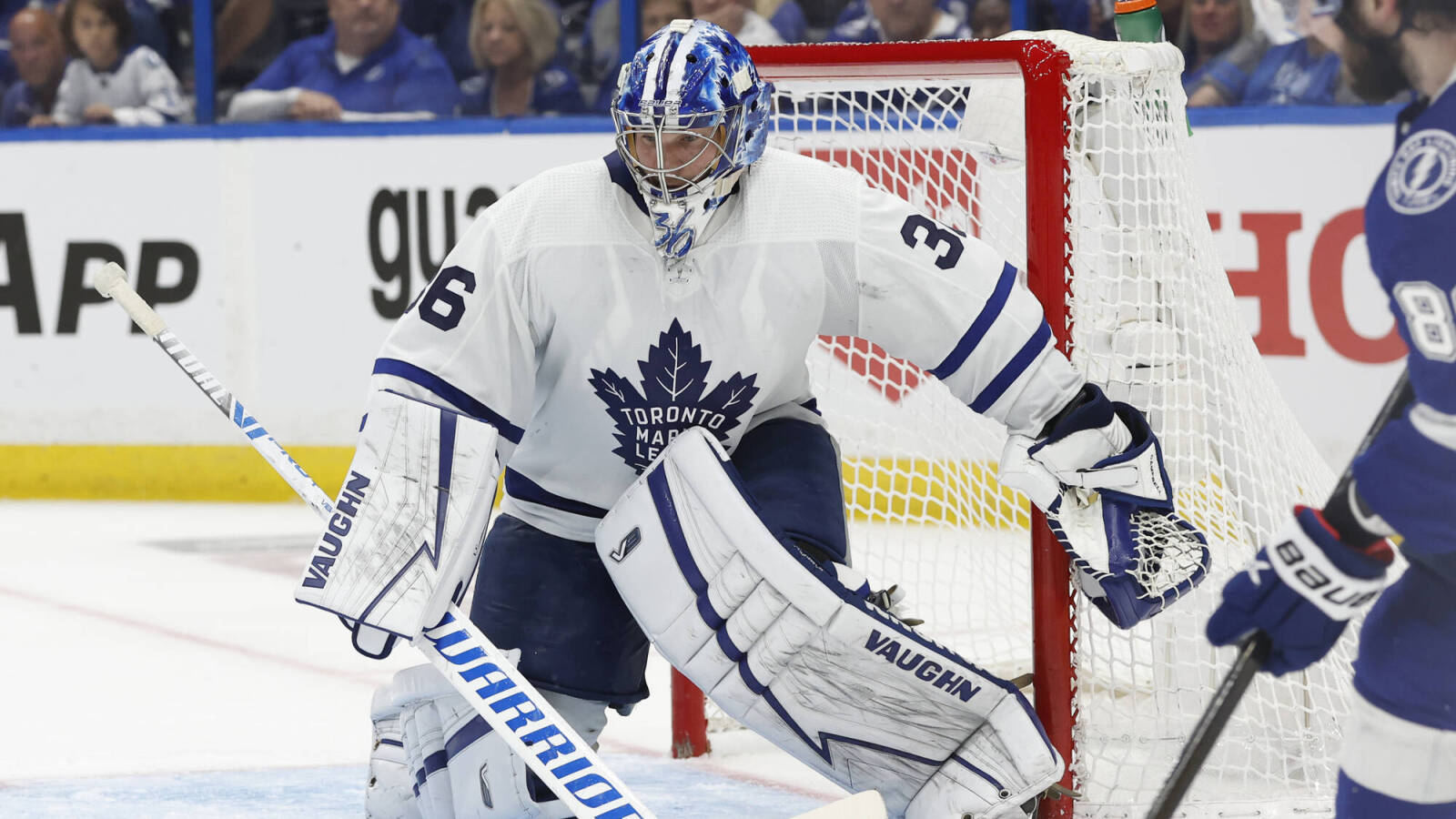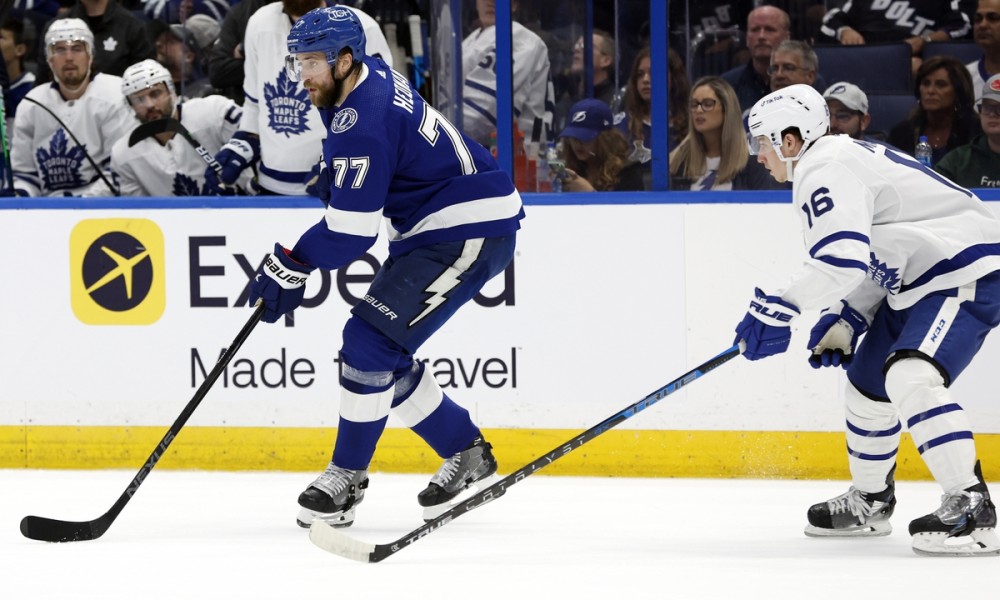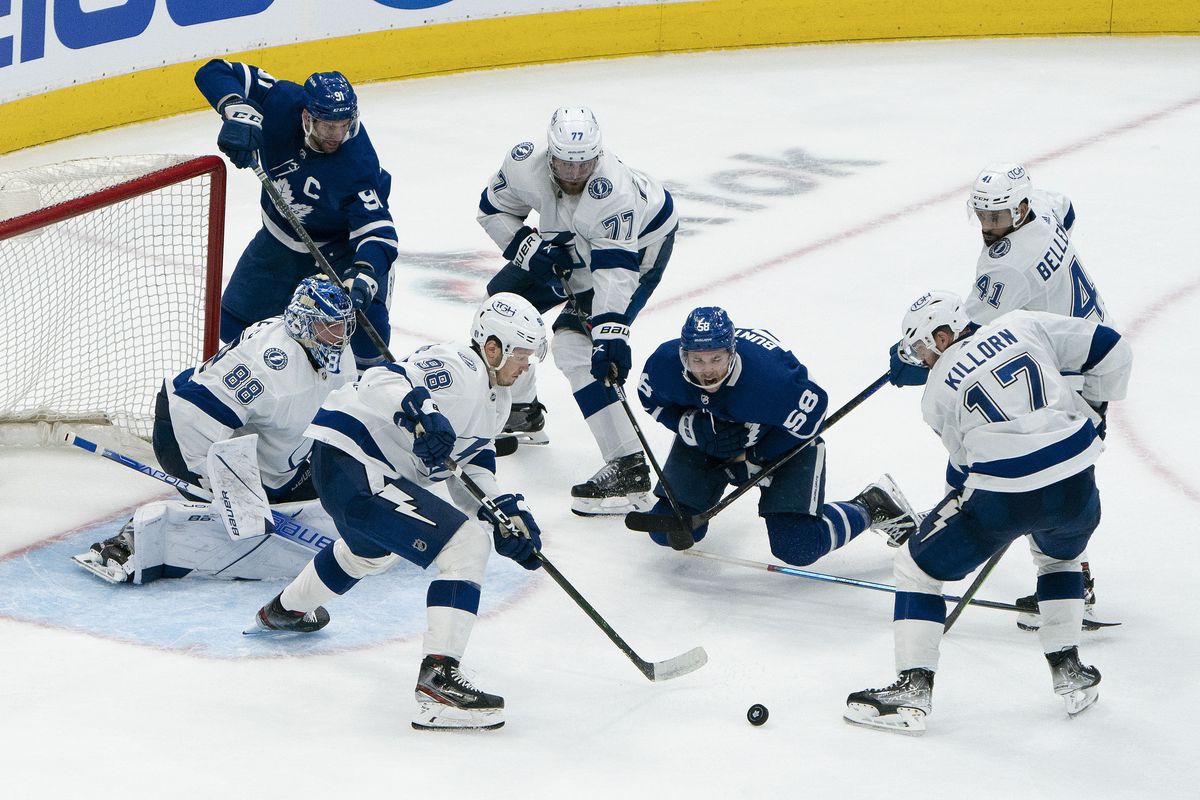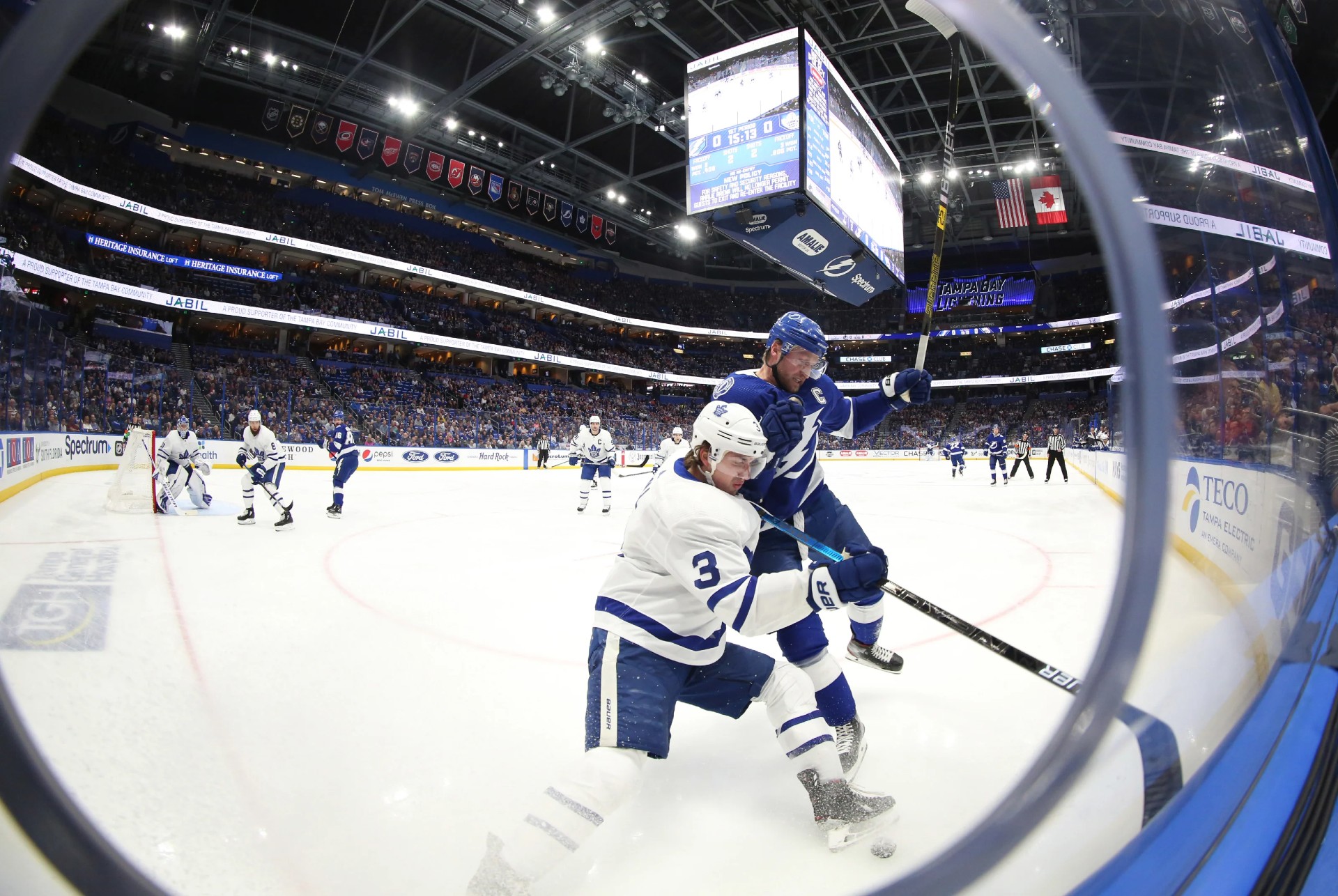With a chance to put this first-round series in a stranglehold, the Toronto Maple Leafs were instead run out of the building 7-3 by the Tampa Bay Lightning in Game 4.
Late to arrive for the game, the Leafs were down 3-0 before you could blink and no serious comeback push ever developed. They were smothered by the Tampa offensive-zone forecheck, unable to break the puck out with any consistency, and were slowed down through the neutral zone as well. The Lightning energy and battle levels were better, their systems ground the Leafs into a pulp, and now the pressure falls back on the Maple Leafs as the series returns to Toronto.
Turning Points

It feels like a violation of the rules to call “the first 10 minutes” a turning point because nothing really turned. The game merely started at a jagged angle, one directly pointed in Tampa Bay’s favour. Right off the hop, the Lightning were juiced and the Leafs were not quite ready for the ferocity of the Tampa offensive-zone forecheck.
The opening minute saw the Leafs play almost exclusively inside their own end. They got it beyond the blue line a couple of times just to see Tampa regroup, toss it back deep, and start the whole process over.
It didn’t take long for the Leafs to crack. Justin Holl was left out to dry on his outlet pass by Ondrej Kaše bolting up ice (you can read Anthony’s breakdown of it from last night), and he turned the puck over. The Lightning jumped on it, cycled the puck around, and teed up Steven Stamkos for a one-time blast:
Steven Stamkos makes it 1-0 early pic.twitter.com/IIpceSLo6d
— Omar (@TicTacTOmar) May 8, 2022
The pressure didn’t stop there, as the Leafs were on their heels routinely for the next five or so minutes. The shots Tampa was generating weren’t of the highest quality, but the Leafs rarely got across center ice with possession. Most of the time, it was a chip out to center and a quick change — the hockey equivalent of a swimmer coming up to gasp for air before going back underwater.
The second goal was mostly puck luck, a bad bounce off the end-boards right into the slot for a waiting Pierre-Edouard Bellemare. But it’s not like the Leafs didn’t deserve it. Pat Maroon scored another goal only a couple of minutes later to make it 3-0 before Jason Spezza took a stupid penalty (though the Leafs killed it off). When it rains, it pours.
Around the halfway point of the first period, Sportsnet’s broadcast flashed the shot attempts and it read “15-2 Tampa.” Your turning point is not one pivotal play swinging the game’s course; it’s this team getting the doors blown off from the opening faceoff and falling behind by three goals in the blink of an eye.
The second turning point came later in the first period. The game had evened out some and the Leafs were finding a little more footing. They started to generate a few decent offensive-zone shifts and their leading goalscorer got a good chance. Auston Matthews received a pass from Mitch Marner in the slot and had a screen from Alex Kerfoot in front. He embarked on his spinning backhand move and saucered it off the iron:
Matthews rifles a backhand off the crossbar pic.twitter.com/GJlhyJNtaM
— Omar (@TicTacTOmar) May 8, 2022
Would Matthews scoring there have resulted in a Leafs win? Doubtful, but it may have provided a path to a more competitive game, as getting one back in that first period could have raised the energy and belief levels for the Leafs. Instead, they went into the break down 3-0.
The final turning point — the one that really locked in what kind of night it was going to be — was the fourth goal allowed. The Lightning were still the better team in the early second period, but the reality is that a 3-0 deficit is not insurmountable. The Leafs held a 3-0 lead just a few nights ago and things got very dicey by the end (not to mention the Leafs coming back from three goals down to force OT in a game in each of the last two playoffs).
It’s doable. But four goals? Against Andrei Vasilevskiy? Probably out of reach. And that’s when Jack Campbell‘s first truly bad goal of the series arrived:
Ross Colton. 4-0 pic.twitter.com/UwDhIvxTt4
— Omar (@TicTacTOmar) May 9, 2022
I didn’t love how far over Ilya Lyubushkin was to the boards at the start of the play, especially when you consider that his defense partner was also on that side of the ice and the fact that Lyubushkin’s footspeed is a weakness. That said, the shot by Ross Colton is not a good one, and Campbell blew it. At that point, the game was over, realistically.
The series is now tied 2-2, and all three turning points occurred in the first 24 minutes of action. The remainder was garbage time for this Leafs team to consider the many adjustments needed for Game 5.
Notable Performances

I thought simply typing “all the players were bad” and then moving on to the next section, but that’s a cop-out, and you all deserve better analysis than that. However, that five-word string is not an inaccurate way to sum up this game. Nobody had a truly good game; either they were poor wire-to-wire or started to shine after the result was already determined.
We can start with William Nylander, who had a bit of a rollercoaster game. All eyes were on him entering the night and he would draw a lot of attention, particularly to American viewers, for this play sequence that the TBS broadcast castigated him for:
Can’t win games in the playoffs with that effort pic.twitter.com/BG3qzWCZJX
— Spittin' Chiclets (@spittinchiclets) May 9, 2022
I don’t think there’s anything here that we don’t already know about Nylander, his tendency to shy away from contact at times, the effort level that rises and falls, etc., but it made for quite the discussion topic in a game his team was getting spanked in. I actually didn’t think Nylander was horrendous overall, or at least not any worse than any other player on Toronto in this one. If you’re squinting for positive takeaways, Nylander finally got on the scoresheet for the series with a PPG on a deflection, and then he added another on a missile slapshot off a Tavares pass. Both of those goals came once the game was out of reach, but they are at least positive to see.
The discussion around John Tavares is starting to get vitriolic, and I’m not going to act like the Leafs don’t need more from their captain. They do. I’m also willing to say he looks slow out there, which he has for a while now. But this wasn’t his worst performance of the series. The pass he made to Nylander on the second goal was excellent and overall, the results of that second line were not bad in the analytics. At 5v5, Tavares/Nylander/Kaše were one of the team’s two best lines per Natural Stat Trick’s data. Again, if you’re squinting for positive glimmers of hope in this dark game, the performances of Tavares and Nylander in the third period are probably about all there was to latch onto.
On the other hand, the top line was subpar yet again. Auston Matthews and Mitch Marner were not able to produce much offense, and though they didn’t get killed in scoring chances or high-danger chances, they couldn’t get out of their own end consistently. The possession metrics at 5v5 like Corsi show that most of the time they were on the ice, the play was happening in the Toronto end. Meanwhile, Brayden Point, Victor Hedman, and Erik Cernak were great again, and that matchup is simply not going the way of the Maple Leafs.
The Leafs will have the ability to meddle with the matchups using last change for Game 5, but to get this series done, those two stars will need to elevate their games again. I do need to give Marner one piece of credit before concluding: he logged 3:46 shorthanded and performed admirably in that time, as the Maple Leaf PK was quietly very good.
Jack Campbell had a bit of a mean reversion performance after he was so stellar in Games 1-3. The first goal was not great, but it wasn’t a howler. Point shots going in without major traffic are not my favorite, but the shooting angle was a bit hidden from bodies up high, and I grade a bit more generously when you remember who the shooter was (Steven Stamkos).
Goals 2 and 3 aren’t on Campbell and are the kind that expected goals models are going to underrate. He made the first save on Pat Maroon, and he can’t be expected to make the second with no help from his defense. The fifth goal (on the 5v3) was also one he had no chance on, but the Colton goal mentioned in the Turning Points section really hurt.
Anytime you give up five goals on only 16 shots, it’s not a great night for the goalie. Now it’s on Campbell to shake it off and lock back into the level of play he had in the first three games while hoping that the team in front of him gives him more support.
Ilya Lyubushkin and Morgan Rielly also had memorably bad performances. They were somewhat at fault for multiple goals, significantly at fault for the Maroon one, and — as noted — partially to blame for the Colton one.
Rielly misread the play in the neutral zone on the Maroon goal, and I thought he could have done more to backcheck after Maroon was away (maybe lay out to try and poke check the puck off Maroon’s stick)? Lyubushkin’s issues with mobility and handling of the puck reared their head yet again when faced with the fearsome Tampa forecheck, and he was eaten up in the chance department. Scoring chances at 5v5 were 13-5 in Tampa’s favor with Lyubushkin on the ice. Sheldon Keefe has a decision to make lineup-wise.
As I pointed out in the Marner paragraph, the penalty kill as a unit deserves some praise in this section. The team deserves to have tomatoes thrown at them for taking that many penalties, but the players who killed them off logged outrageous amounts of time shorthanded and made it out only surrendering one goal in eight opportunities — and that one goal was on an extended 5v3.
Justin Holl, Jake Muzzin, TJ Brodie, and Mark Giordano all played ~five minutes on the PK, as did David Kämpf at forward, while Marner, Ilya Mikheyev, Ondrej Kaše, and Alex Kerfoot all logged substantial time (two or three minutes each) shorthanded. The score ended up being ugly, but somehow it could’ve been even uglier without the efforts of this gang.
Storylines for Game 5

1. A full lineup re-evaluation now needs to be undertaken by Sheldon Keefe, so we’ll start with the forwards here. I floated the idea of breaking Matthews and Marner up after last game and a second straight game of them getting stuffed in a locker at 5v5 has done nothing to tame my interest in the idea. Perhaps Keefe feels that being able to put them out there against someone other than the Cirelli-Point-Killorn line using the last change will re-ignite them (he may be right!), but obviously, the first big lineup decision occurs there. After that, it seems like Michael Bunting will be back on that line as he returned there in the third period of Game 4.
I have no issues leaving the checking line together and the second line did alright, as mentioned previously. If you’re going to leave the first line intact, there won’t be major shakeups in the top nine.
The other major decision comes on the fourth line. Jason Spezza was not terribly noticeable in this game, and Colin Blackwell‘s results were extremely poor at 5v5. Do we see someone like Wayne Simmonds or Kyle Clifford draw back in? I am not all that interested in the proposition, but perhaps Keefe feels that he needs to re-establish a bit of an edge or shake something up.
2. The defense is even more interesting to me. I would take Lyubushkin out and insert Timothy Liljegren. Lyubushkin has become an obvious target whose shortcomings are preyed on by the fast, forechecking style of Tampa. I do not love the idea of playing Liljegren with Rielly, but on the other hand, any other move completely busts up the pairs the Leafs have been running with. Muzzin-Liljegren and Rielly-Brodie perhaps make a bit more sense, although it wouldn’t shock me if Keefe went back to the old faithfuls: Rielly-Brodie, Muzzin-Holl, and Giordano-Liljegren.
3. The penalty situation is a major factor to monitor after this game. The Leafs took nine minor penalties, eight of which that gave the Lightning some power-play time. After the Lightning were the ones with the so-called “parade to the penalty box,” as John Cooper referred to it, in Game 3, the script reversed in this game. The Toronto PK showed up in this one, but that is not a winning formula moving forward.
The Leafs need to keep it to three or maybe four minor penalties (not counting offsetting calls) to have a realistic shot to win in Game 5. You cannot give a team like Tampa that many opportunities with the man-advantage, not to mention how it disrupts the rhythm of the game, the ice time shares that fall heavily on the penalty killers, and all of the other ripple effects. Stupid penalties — ones like Spezza’s crosscheck or Kämpf’s delay of game infraction — need to be kept to a minimum, especially.
4. Breakouts, breakouts, breakouts. The Leafs have not been able to get out of their own zone with consistency for multiple games in a row now. It was somewhat of an issue in Game 2, gave them fits in Game 3, and morphed into a full-blown five-alarm fire in Game 4.
The Tampa forecheck has been ratcheted up, and it has been suffocating. The forechecking forwards are well positioned to cut off passing angles, they hit the end boards hard, and they take away time and space. Pinches down the wall from the defensemen have been firing at a clip near 100% efficiency for two games now.
The Leafs need to be crisp in their zone exits, with multiple outlet options for defensemen to make that first pass in case one of the potential destinations is sealed off, and their wingers need to win more board battles. The success of Tampa’s offensive-zone forecheck has been tied to their ability to mitigate Toronto’s speed advantage in the last couple of games. They’ve forced the Leafs into chipping the puck out to center ice and then going for a change rather than countering with rush opportunities.
Moreover, the defense pinching has been so successful that the Lightning have rarely been put in the situation where the puck squibs past the point defenseman and a rush chance develops. If the Maple Leafs can string together more cohesive breakouts, more opportunities to turn defense into offense open up as well.
5. Well, here we are. It’s a best 2-out-of-3 series now, and the Maple Leafs are still in a solid spot, no matter how badly Game 4 went. They got shelled, but that’s out of sight and out of mind. As has been stated twice now during the course of this series, the Tampa Bay Lightning are experts at bouncing back from losses. The Leafs did so in Game 3, and now they will need to prove it yet again.
This article may read like a “sky is falling” summary, but it isn’t. Neither team has the upper hand. Rather, both have showcased reasons why they can win this series. This week, we’ll find out which one will prevail.
For the Leafs, they need to break through the Tampa forecheck, get more from their core four forwards, and get another couple of strong goaltending showings from Campbell. For the Lightning, they need to stick to what they’re doing on the cycle, stay out of the box, and continue to win puck battles using their physical edge.
Both teams need to start strong in Game 5, as the team to score first has won all four games. Beyond just that stat, we noted in the Turning Points section that the start to this game dictated how it was going to go. The Leafs killing off a five-minute major in Game 1 and scoring twice early on in Game 3 set the tone for their two wins.
The Lightning looked and played like the team more in need of a win in Game 4. But both teams need Game 5 equally. Who can start strongest is my biggest storyline to watch for Game 5.






























![New Leaf Anthony Stolarz on the opportunity in Toronto: “In Florida, I knew my role as a backup… Now, [Joseph Woll] and I are competing for starts… As a goalie, that’s all you can ask for” Anthony Stolarz, Stanley Cup win, now Maple Leaf](https://mapleleafshotstove.com/wp-content/uploads/2024/07/anthony-stolarz-sc-100x70.jpg)
